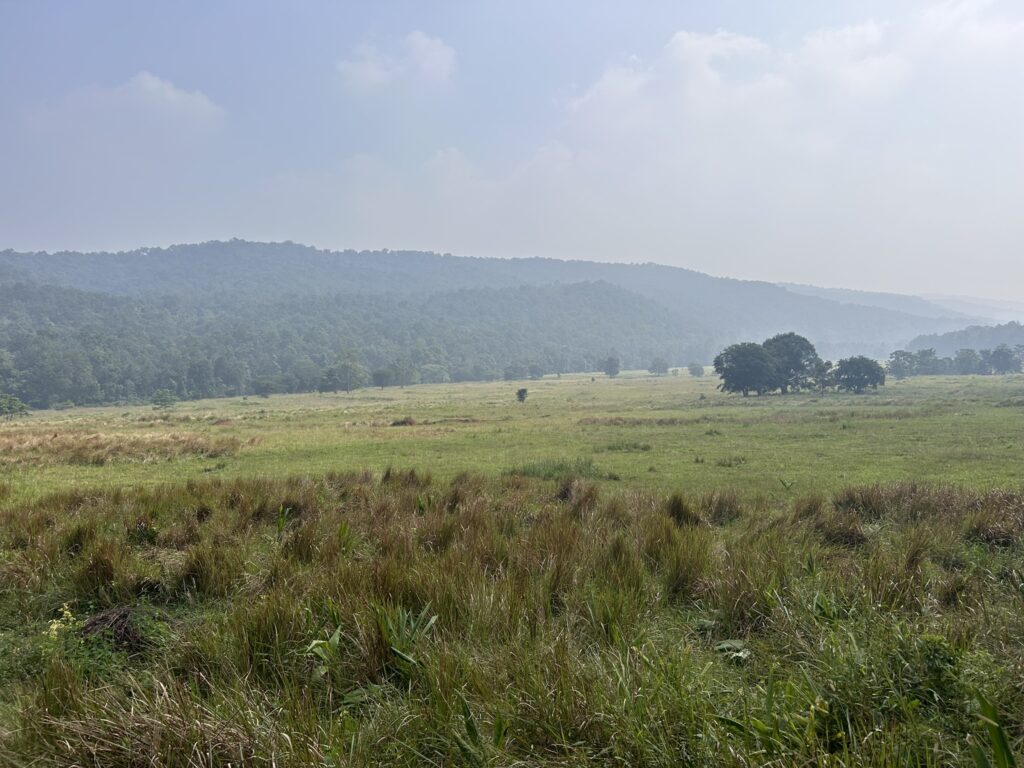by Rajaraman Sundaresan and Pradyumna Behera
India’s model of colonial conservation uproots Indigenous communities who have coexisted with wildlife for generations, turning forests into constructed ‘wild’ tourist spectacles for profit.
“If all the world loves a zoo, what an attraction a night in the jungles would be. Hong Kong, Tokyo, Honolulu, Rome, Paris, London and New York can’t produce a night in the jungle. We can – but what are we doing about it? Precious little! If our beloved wild game must have a financial reason for survival, surely this is one. Excellent accommodation, suitable vehicles, good food, wine and moon, as successive groups spend just one day in exotic surroundings.”
– Lines from the proceedings of the Special Meeting of the National Board for Wildlife with International Union for Conservation of Nature (IUCN) and WWF held in 1965 when the idea of conservation areas was being planned in India.
Spanning nearly a million sq. km of India’s landmass, Tiger Reserves are fast expanding in magnitude and might. While these large portions of forests remain under the sovereign control of the state forest departments in line with the colonial legacy, Indigenous and forest-dwelling communities are being coerced and evicted not just to make tiger numbers soar but also because these forests are the last remaining frontiers for tourism capital.
India’s tiger reserves are being emptied of people – nearly 65.000 families are going to be evicted from their forests. Why? – because India’s wildlife “experts” – the “authoritarian biologists” influenced by Cartesian science – believe that tigers and humans cannot co-exist. The recent National Tiger Conservation Authority (NTCA) order to expedite evictions of villages from tiger reserves reiterates this colonial dogma.

A picture of the resettlement colony where the people of Jamunagarh from Similipal Tiger Reserve currently live after their coerced evictions (Photo by Rajaraman Sundaresan).
The order issued earlier last year triggered protests across several states in India, where communities questioned the motive behind such a diktat, which they said was a continuation of the historical injustice against them and that the letter was a direct violation of constitutional rights.
Why should tiger numbers soar? Is it just about the attractive potential of a feline, its constructed masculinity, and the national pride it carries in geopolitics? How many tigers does it require to gratify this national pride? Or is it yet another developmental façade to extract profits out of peoples’ lands and lives? The exoticness of a life form might appear as a consumable spectacle, but do we even comprehend the everyday violence that undergirds this Great Indian Tiger Show?
The extractivist taming of forests and its life forms has a long history. Whether it was the colonial model of game-hunting widespread until the 1970s or the current model of voyeuristic gazing at the ‘wild’, this trajectory has much to reveal about the moorings of India’s conservation industry.
In its recent report, Ministry of Environment, Forest and Climate Change of India (MoEFCC) envisions that each Tiger Reserve can reap 2.500 rupees out of every single rupee invested. This report aims to reduce tiger habitats into marketable commodities by “making the hidden visible”. Tiger Reserves are now “engines of economic growth” wherein tourism is a strategic component in the array of ecosystem services –an idea that reorders nature-society relations merely into a profiteering transaction.
The foundation of this conservation-tourism nexus was laid out by India’s elite political class during IUCN’s General Assembly held in New Delhi in 1969 under the patronage of the then-Prime Minister Indira Gandhi. It was the same assembly wherein transnational lobbies like WWF began influencing India’s conservation future.
This nexus orchestrated by the cartesian psyche not only constructed ‘wilderness’ as a fetish commodity that ought to be harnessed through tourism but also used conservation as a mask to legitimise it.

Salt licks used as tourism baits created inside the core area of Similipal Tiger Reserve. (Photo by: Special Arrangement).
The idea of tourism has certainly altered the way tigers are being managed; not conserved, to say the least. Forests, in many ways, have become spectacle-scapes where the tiger is being domesticated and stage-managed for tourists.
In order to attract more tourists and guarantee sightings, salt-licks and artificial meadows are being created as baits for spectacular gazing. Vegetation is cleared off adjacent to Safari trails so that tourists can relish the gaze from their high-end safari vehicles.
Accordingly, Tiger Reserves have become cathartic sites for city-dwellers to appear in Safari vehicles with cameras hanging around their necks. This is nothing less than a performance of consuming the ‘wild’, which is monetized and fashioned into ecotourism. Should we be calling this conservation at all?

Tourists at Tadoba-Andheri Tiger Reserve clogging around a tiger (for representational purpose; Photo by Kedar Gore).
Ultimately, who is benefitting from this engineering of nature? Definitely not the tiger and the forest-dwelling communities. In the name of tiger conservation, communities have been systemically denied access to forests and uprooted not only from their homelands but also from their inter-generational knowledge systems that ensure the sharing of living space with all life forms. This historical disruption amongst the communities not only led to the denial of their agency in conserving their homelands but also manufactured the ‘Tribal versus Tiger’ sensation.
Indigenous and forest-dwelling communities, who have lived alongside tigers for generations, are the real victims of this conservation-tourism nexus. Data reveals that more than 25.000 families have been evicted from their own lands to not only make tiger numbers soar but also to engineer these landscapes into tourism hotspots.

The deserted Kabatghai village in the core area of Similipal Tiger Reserve now turned into a meadow for safari tourism. (Photo by: Special Arrangement).
There are countless accounts of forced evictions from Tiger Reserves on the pretext of creating inviolate spaces. For instance, the Munda Adivasis of Jamunagarh village in Similipal, despite their long resistance against displacement, were coerced and resettled some few hundred kilometres away from their lands.
As we write, their lands have now been opened up for safari tourism while the people of Jamunagarh linger in destitution. The elders of the village are dying, the men and youth have become addicted to alcohol, and the women suffer from alienation trauma. Though the relationship of the people of Jamunagarh with their lands has been erased, they still recount the memories of the same lands on which they shared equal space with tigers. They recount how, on several occasions, tigers gave birth in the vicinity of their village. This, they argue, was possible only because their worldview always accommodated every life-form as kin to be cared for and respected.
Across India, many Indigenous communities who are resisting dispossession from their ancestral lands in the name of tiger tourism continue to raise questions over this very model of colonial conservation practices – if we are being evicted out to make tigers feel safer, why are the tourists being taken into the forests?

Three generations of Jenu Kuruba men, along with their Shaman JK Thimma, sitting in Nagarahole forests discussing the impacts of tourism on wildlife and the forests. (Photo by Rajaraman Sundaresan).




